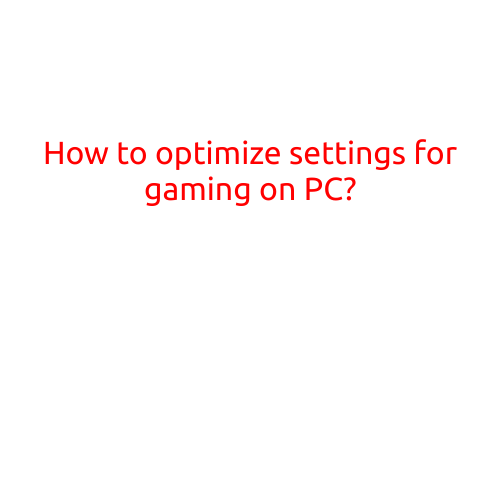
How to Optimize Settings for Gaming on PC?
Gaming on a PC can be an incredible experience, but achieving optimal performance requires some tweaking of settings. With so many options available, it can be overwhelming to know where to start. In this article, we’ll walk you through the process of optimizing your PC gaming settings to ensure a smooth, lag-free, and enjoyable experience.
Step 1: Check Your System Requirements
Before you start adjusting settings, make sure your PC meets the minimum system requirements for the games you want to play. This information can usually be found on the game’s official website or in the game’s documentation. Check the recommended CPU, RAM, and GPU specifications to ensure your PC can handle the demands of the game.
Step 2: Update Your Graphics Card Drivers
Outdated graphics card drivers can cause performance issues and overheating. Make sure your graphics card drivers are up-to-date by following these steps:
- Go to the manufacturer’s website (e.g., NVIDIA or AMD)
- Download and install the latest driver version
- Restart your PC
Step 3: Adjust Graphics Settings
Graphics settings can greatly impact game performance. Here are some key settings to adjust:
- Resolution: Lowering the resolution can improve performance, but may reduce image quality. Aim for a resolution that balances performance and visual quality.
- Graphics Quality: Adjust the graphics quality settings to find a balance between performance and visual quality. Options include:
- Anti-Aliasing (AA): Helps reduce jagged edges and improves image quality
- Anisotropic Filtering (AF): Improves texture quality and reduces aliasing
- Texture Quality: Adjusts the detail and smoothness of textures
- Shadow Quality: Adjusts the detail and quality of shadows
- Frame Rate: Set a target frame rate to ensure smooth game performance. Aim for 60 FPS or higher for a smooth experience.
Step 4: Tweak In-Game Settings
In-game settings can also impact performance. Look for options like:
- Field of View (FOV): Adjusting the FOV can improve performance and immersion
- Physics: Disable physics-intensive settings like dynamic lighting or destructible environments
- Motion Blur: Turn off motion blur to improve performance and reduce eye strain
Step 5: Adjust System Settings
System settings can also impact gaming performance. Consider:
- CPU Priority: Set the CPU priority to “High” to ensure the CPU devotes resources to gaming
- Power Saving Mode: Disable power saving modes to ensure consistent performance
- Disc Cleanup: Regularly clean up your disk space to prevent crashes and slow performance
Step 6: Monitor Your System Performance
Use system monitoring tools like GPU-Z, CPU-Z, or FRAPS to track your system performance in real-time. This will help you identify bottlenecks and optimize settings accordingly.
Step 7: Experiment and Refine
Gaming performance is highly dependent on the specific game and system configuration. Experiment with different settings and monitor your system performance to find the optimal balance between performance and visual quality.
Conclusion
Optimizing your gaming settings is a process that requires patience and experimentation. By following these steps, you’ll be well on your way to achieving optimal performance and enjoying a smooth, lag-free gaming experience. Remember to regularly check for updates and system requirements to ensure your PC remains compatible with the latest games. Happy gaming!





